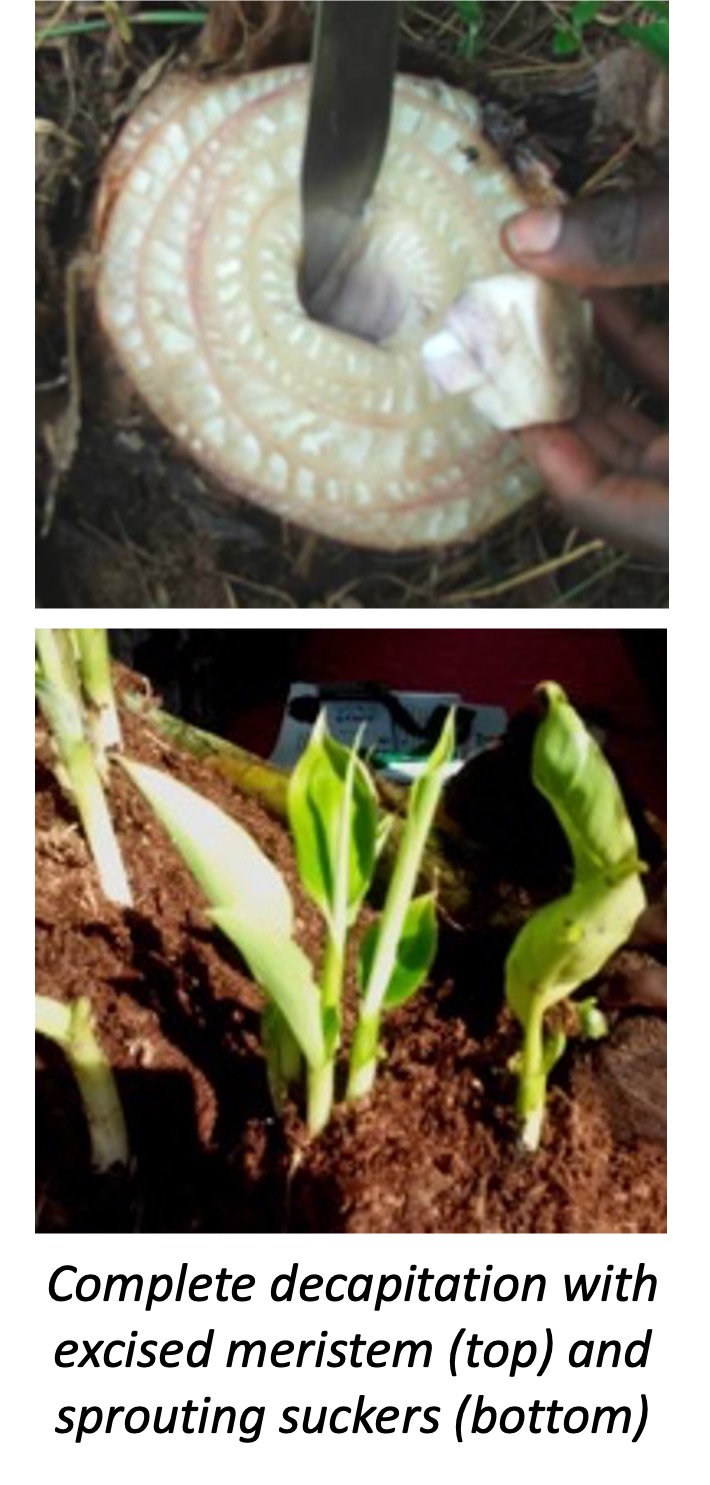Propagation of Disease-Cleaned Suckers
Summary
Farmers in Africa depend on natural vegetative regeneration mechanisms of banana and plantain for the supply of planting materials but these are often contaminated by pests and diseases than undermine productivity and lifespan. Suckers are traded on local markets which forms an important source of income for farmers. Sword suckers are lateral shoots with thin leaves and a pseudostem length of 80 to 120 cm, which naturally develop at the flowering stage. Their macro-propagation is based upon the removal of the apical dominance to stimulate additional sprouting of suckers. It involves simple techniques that can supply large quantities of disease- and pest-free seedlings at affordable prices, including planting material from earlier released high-yielding hybrid varieties.
About the Solution
Macro-propagation of suckers can be classified into two categories: field-based techniques relying, based on decapitation, and detached corm techniques conducted in beds. The complete and false decapitation techniques involve stimulating lateral production of sucker buds by destroying the meristematic corm and triggering accelerated sprouting. Using partial decapitation, a small hole is made in the pseudostem through which the meristem is destroyed. The foliage remains physiologically active for about three months thereafter. Using complete decapitation, the pseudostem is cut down, destroying the meristem. Detached corm techniques involve excised buds or plants resulting from stem fragments. A higher number of seedlings and greater growth uniformity is achieved by the detached corm technique than from pseudostem decapitation, and plantlets obtained from corms are less prone to stress once established in the field. It is very important that the starting material for macro-propagation is free of pests and diseases.
To increase banana production, farmers should have access to affordable, high-quality vegetative seedlings that are free of pests and diseases. For all methods of macro-propagation, knives must be cleaned with boiled water to avoid disease transmission. The detached corm technique requires that hardened sprouts are used.
Convenient dimensions of a propagation chamber are 1.5 m wide, 5 m long and 1 m high. It should be covered by transparent polyethylene and be at least 50% shaded. Plastic covers must be fitted to ensure high humidity and temperature. These chambers are filled with a mixture of soil; composted manure; and sawdust, coffee husk, rice husks, oil palm fiber or cocoa fiber at a ratio of 6:3:1. The substrate must be steam-sterilized by placing it on top of a metal drum containing boiling water.
The technique of false decapitation starts by making a square incision of 5 cm wide at 20 cm from the ground level up to the middle of the pseudostem using a 6-month-old plant, killing the active meristem. Angle the bottom side of the hole slightly downwards so water and plant sap collect in the hole to further kill the meristem. Decapitated plants are left for at least one month to allow sprouting. For complete decapitation the apical dominance is removed by cutting down a 6-month-old plant to the ground level and excising the middle 5 cm of the softer meristem leaving the harder corm intact. The cut stem should be covered with soil to promote sprouting. Within three weeks, four to seven suckers will emerge. Suckers with three to four leaves are detached by pulling them from the pseudostem and transplanted to the field. For macro-propagation using the detached corm technique, the source material are healthy suckers collected between flowering and harvest. Roots are cut from suckers and washed before peeling leaf sheaths. The whole corm is then sanitized by submerging it in boiling water for 30-40 minutes (or fungicide for 20 minutes. Corms are scarified by making a shallow incision at the top and then left to air dry for 24 hours. Whole corms are planted in the weaning chamber at 30 cm distance, or the corm is split into 2 or 3 fragments or buds are excised in pieces of 50-100 g that are planted at 10 cm distance, and are covered with 2 cm of sawdust.
Commercialization
Commercially available
Solution Images
Institutions



